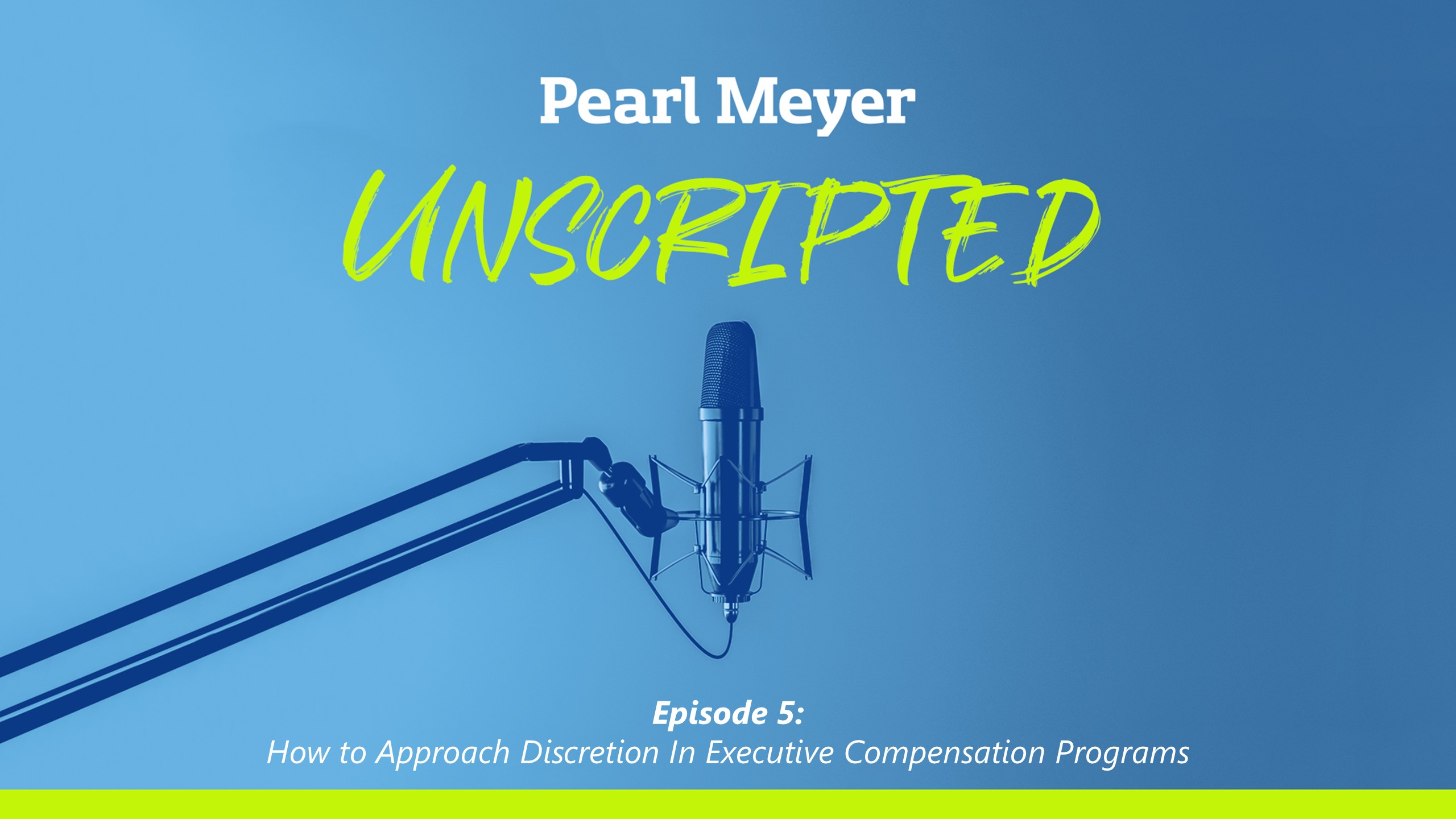
Podcast | Oct 2025 | The Pearl Meyer Unscripted Podcast
How to Approach Discretion In Executive Compensation Programs
S2 Ep5: How discretion can help align pay with performance without undermining incentive integrity.
Introduction
Jake: When the unexpected happens to your business, how does the compensation committee determine whether and how to adjust incentive programs?
Hi, I'm Jake George, CMO at Pearl Meyer, bringing you another episode of Unscripted. Today, Mark Rosen and Aalap Shah are joined by our colleague, Greg Stoeckel, to delve into the world of discretion. Discretion is a tool that can be employed by comp committees when the unexpected arises, but it's only used rarely. When is the right time to consider discretion? Let's listen in...
Mark: Hey, Aalap, how are you doing today?
Aalap: Oh, I've had better days, Mark. I just got word that actually two of my clients are having some problems with their incentive programs. Their goals got blown up because of some unforeseen business changes. And we have a meeting coming up for both of them to try to figure out what to do.
Mark: Yeah, I wish it was less common than it was, but it happens. You know, Greg Stoeckel has been doing a bunch of work in this area, so let's talk to him. I brought him along to sort of give us some guidance on what we should do because I to have some clients with a similar problem.
Hey, Greg, how are you?
Greg Stoeckel: Doing great, how are you, Mark?
Mark: Great. You know, Aalap and I have been thinking about this issue, what do we do when we have these plans that for unforeseen reasons, there not going to work; we're halfway through the year and we got a problem.
Greg: Yeah, it's a great question. As you said, this comes up more often than you would expect. And this puts us squarely in the land of compensation committees needing to think about using discretion. And that could be a word that scares some directors from time to time. But if you just think of discretion as judgment, then I think it sort of softens it and says, 'look, we're just trying to do the right thing here.' And you got to realize that when you set performance goals, that's at one time a year - halfway through the year, 3 quarters of the way through the year, circumstance can be quite different. And so you see this most often in short-term incentive plan designs where there may be a need to sort of override the formula result to get to the right relationship between pay and performance given all facts and circumstances.
Aalap: But Greg, I mean, what kind of key considerations or risks do committee members need to consider when evaluating using discretion?
Greg: Yeah, that's a great question Aalap. I think there's sort of the internal considerations and then there's external considerations and both are really important. So, internally you have to worry about sort of the integrity of your incentive programs, right? We don't want to have frequent overriding of results because then people won't trust the incentive structure itself and it won't produce the behaviors that we're looking for. So internally, I would say communication is key anytime that you override a formula and use judgment to try to get to the right answer you really have to do a good job explaining why that is.
Externally, I would say, if you include named executive officers, you've got a proxy disclosure concern that you need to think about. So, shareholder optics is certainly an important consideration anytime you're in this area of thinking about applying judgment or discretion to what otherwise would have been formulaic payout results.
Aalap: One other question because most of the time when I'm dealing with this, we're talking about negative discretion. Do you have a sense of how much is too much? I get asked that question often.
Greg: Yeah, that's another great question. I would say, the way I think about this is it's about calibration, right? And so a good analogy might be sort of a dimmer switch, that you might have in your home, right? This is about turning it up, turning it down a little bit to get to the right spot. Don't think of discretion or judgment as being an on-off switch.
Mark: Yeah, but wait a minute, what are we talking about when we talk negative discretion?
Greg: So what we're talking about here is looking at all the facts and circumstances and saying, 'you know what, we just think based on the totality of what's going on with the business, based on what management has done or hasn't done, that we need to reduce the payout that the formula suggests' for whatever the facts and circumstances might be. So negative discretion is taking one result, lowering it in order to achieve that desired link between pay and performance.
Mark: So if we had some sort of windfall because for whatever reason we sold a business unit or we recognized some sort of huge gain that was one time but for some reason it was included in the formula, we might consider not including it?
Greg: That's right.
Mark: I could see a lot of pushback when it looks like we're going to have a good payout but you all of sudden decide that you know maybe we shouldn't pay it out at that level.
Greg: That's why I think using this, you know, sparingly, only using it in cases where it's important to get to the right answer, but you're exactly right. Sometimes there are things that happen that are unexpectedly positive for the business. It wasn't a direct result of effort or leadership. So again, trying to account for that through the use of discretion, both positive and negative, is an important function of the compensation committee, right? We always say, 'executive compensation is pretty complicated, you shouldn't expect it to be always reduced to a simple formula.' So that's why we have the committee members there is to, again, look at the totality of the facts and circumstances and make the right decision.
Mark: Yeah, I can't say that I have near as many situations where we are going to consider using negative discretion. Far more circumstances where we've set some targets that halfway into the year we realize that through no fault, maybe because it's our bad forecasting, but for whatever reason there's some tremendous headwinds and it doesn't look like we're going to pay anything out. How do we keep people motivated the rest of year?
Greg: Yeah, that's exactly right. So if you think about some examples, maybe, I would throw out there, natural disasters, right? These are things you can't predict. Think about hurricanes, fires, etc. To let an incentive program go to zero because of things that were completely outside the control of management, that really is an important question. And we see that a lot sort of in the hospitality space. Think if you're running resorts and half of your resorts are closed because of natural disasters. We'll also see it with regard to things like wars, other government policies, right? Part of our budget was business in China or Ukraine, and we can't do business in those countries for some reason and so, the actual results of the business relative to those initial goals are going to be a zero, but is that really the right outcome for the business?
Mark: And don't you care a lot about the shareholder experience? I mean, how much discretion or judgment would you want to use in a situation where our stock price is down materially?
Greg: Yeah, I think, you know, again, part of the thinking about it from a total perspective, that is certainly a consideration. And in some cases you'll see not a one-size-fits-all solution for the application of discretion. So at some level in the organization, realizing that sort of, you know, the buck stops here, we've all heard that expression. So, maybe we don't make any kind of an adjustment at a certain level and above, could be senior vice president and above, could be named executive officers and above, could just be for the CEO to say, 'look, we still have accountability for the shareholder experience, but for people lower than whatever level we've identified, to keep their head in the game, they're probably working twice as hard, they're achieving great results. It really was outside of their control. And so could we think about applying discretion or judgment at certain levels within the company, but maybe not all levels.'
Aalap: And I think the point on communication here is probably very key. Especially when you're doing positive discretion or differentiating amongst levels, how do you communicate that this is a favorable thing to do for a company versus it being perceived as an unfavorable thing?
Greg: The whole goal here is to try to get the right relationship between pay and performance. And positive discretion is certainly trickier from an external optics perspective than negative discretion. I think most shareholders would say negative discretion makes sense, positive discretion is a little harder to justify. So again, I think in proxy disclosures and in just internal communications with the comp committee and the board, just making sure you have a thoughtful process that you went through get to the right answer. Sometimes I've talked about this as the "Four T's" of good versus bad discretion and those T's are: it's got to be Thoughtful, it's got to be Transparent, it's got to be Timely, and it's got to be Tailored. And we've already hit on several of those things, right? So Thoughtful meaning we considered a lot of other alternatives and this is the right one for us. Transparent, both internally and externally in terms of what we're doing. Timely meaning it's close in time to the event that we're dealing with. We didn't let a lot of time go by before we decided to take action and then Tailored is that aspect of just customizing it to the situation. Maybe some groups are included, some groups are excluded.
Aalap: Yeah, Greg I wonder if there's another tailoring aspect to this as well. And by the way, I love the Four T description, definitely going to steal that. Predominantly when we're talking about discretion, we're talking about annual incentive plans. I think Mark and I, Mark, you probably would agree, we get asked often whether or not you could apply discretion in your long-term incentive program. I mean, do you have any guidance on that?
Greg: Yeah, I think there's two things that I usually think about in that regard. Number one is over the longer term, you tend to have more ability to react to facts and circumstances. And so I think that's one of the reasons why you see less use of discretion in long-term versus short-term incentive plans. But the bigger one is that, you know, for companies that are using equity-based long-term incentives, you know, one of the real advantages is the fixed grant date accounting of these awards and so if we've got a program where we're going to be able to apply discretion at the end that could put that favorable grant date accounting at risk and eliminate one of the real advantages of stock-based compensation over cash compensation.
Aalap: So just as a follow up, let's say you vetted both of those issues, would you say it's a big no-no to put any discretion in incentive plan, or is it kind of a facts and circumstances type of decision?
Greg: I think it's still facts and circumstances based, right? I wouldn't let the accounting drive the right decision, but you need to be aware of the consequences of those decisions. And so you would hardly ever see discretion built into the design at the front end because then you're guaranteeing the bad result. But if you choose to apply discretion or judgment at the end, just know that there is potentially an accounting consequence there that is bigger than you would otherwise have.
Mark: But that just doesn't happen very often. We don't make adjustments to long-term incentive plans very often because you're going to grant the next year and you can adjust in the next year's grant, both in terms of what the performance is or the size of the grant. That might be a better way to address the issue.
Greg: That's right, that's right. There's a layering effect clearly, especially if you're talking about PSUs or performance shares, right? These are the programs where we've got metrics and goals over multi-year periods. And so you're exactly right, Mark. You get a chance to reset those next year. And that's going to, more often than not, be a better solution than trying to adjust the in-flight programs.
Aalap: Yeah. And frankly, I think just another aspect of judgement because you do have the flexibility to adjust following your awards. And so, is it better to do that? Or is it better to adjust an in-cycle payout? As we were talking about before, it is really sort of the board exercising its judgment on what's more appropriate.
Mark: Greg, where have you seen these work particularly well, or not work well, especially in light of what investors are going to say?
Greg: Yeah, I think the key here is going back again to kind of those Four T's that we talked about with a real emphasis on Transparency, right? So, the times that this goes well from a shareholder perspective is when we've been very thoughtful about it. We've been transparent and we've managed the disclosure in such a way that says 'here were the circumstances we were facing, here were the alternatives we considered, here was the solution we adopted and here's we thought that was the right thing for the business.' That's going to give you a better than not chance of having a more successful outcome from a shareholder or investor perspective.
Aalap: And so, Greg, I mean, just asking you to crystal ball this a little bit, but do you see the pendulum swinging toward more rigid, formulaic structures or leaning more towards applying discretion? Again, using your Four T approach.
Greg: Yeah, I think we're going to continue to see use of discretion in incentive plans. Again, it's very difficult to think about reducing executive compensation to a simple formula. So discretion is going to continue to be something that compensation committee members are going to have to grapple with.
I will say though, that lot of companies are trying to make their incentive programs a little more resilient. And by resilient, I mean trying to minimize the occasions where discretion might be necessary. And some of those tactics are things like widening the performance ranges to account for more variable outcomes, things like having a flat part of the payout curve around target to say we're not exactly sure when we set our budgets if that's the exact spot or more of a range. And then there's a variety of other mechanisms again from a design standpoint. So, I feel like the general trend is to try to design your incentive programs to be more flexible and allow for more variable outcomes and then reserve this use of discretion or judgment on a more limited basis where even those strategies didn't produce the best result for the business.
Mark: Hey, Greg, isn't there a way to mitigate the potential use of judgment or discretion? I mean, some companies that are more subject to commodity prices, for example, they don't have 100% of their incentive, especially their annual incentive, based solely on financial metrics.
Greg: That's exactly right, Mark. Yeah. So if you're in a cyclical business or as you say, one that's highly impacted by external factors that can move on you pretty quickly, it is quite common to carve out a portion of the incentive program, let's say 20-25% perhaps, and have it be based on metrics that are much more in the control of management. So non-financial metrics, but that have a financial impact. Some companies will call this strategic objectives and have two or three objectives that each have a certain weight. Some companies will look at safety, utilization, other operating type metrics as a way to sort of diversify the program away from a pure play financial formula, which has a lot of uncertainty in it.
Aalap: Thanks, Greg. Really appreciate the time. And I really like this idea of rethinking your incentive programs and see if they can make them more resilient. And then, using your Four T test to apply discretion on a potentially sparingly basis. So, thanks a lot. I think this gives me a lot to go into my meetings with.
Greg: Awesome, great to see you both.
Aalap: Take care, bye.
Mark: Bye.
Jake: Well, that raps up our look at hot topics on the fall committee agenda, but it's not the end of our season quite yet. Next week, Mark and Aalap will be back to close out season two with a review of the regulatory environment, including a look ahead to the 2026 proxy season and a discussion of expected rule changes being developed by the SEC. You can find that episode where you found this one. On Spotify, pearlmeyer.com, or wherever you get your podcasts. Thanks for listening.
Look for new episodes each Monday afternoon at Pearl Meyer Unscripted, subscribe to our YouTube Channel, and listen on Spotify.



